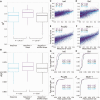Covariation between homeodomain transcription factors and the shape of their DNA binding sites
- PMID: 24078250
- PMCID: PMC3874178
- DOI: 10.1093/nar/gkt862
Covariation between homeodomain transcription factors and the shape of their DNA binding sites
Abstract
Protein-DNA recognition is a critical component of gene regulatory processes but the underlying molecular mechanisms are not yet completely understood. Whereas the DNA binding preferences of transcription factors (TFs) are commonly described using nucleotide sequences, the 3D DNA structure is recognized by proteins and is crucial for achieving binding specificity. However, the ability to analyze DNA shape in a high-throughput manner made it only recently feasible to integrate structural information into studies of protein-DNA binding. Here we focused on the homeodomain family of TFs and analyzed the DNA shape of thousands of their DNA binding sites, investigating the covariation between the protein sequence and the sequence and shape of their DNA targets. We found distinct homeodomain regions that were more correlated with either the nucleotide sequence or the DNA shape of their preferred binding sites, demonstrating different readout mechanisms through which homeodomains attain DNA binding specificity. We identified specific homeodomain residues that likely play key roles in DNA recognition via shape readout. Finally, we showed that adding DNA shape information when characterizing binding sites improved the prediction accuracy of homeodomain binding specificities. Taken together, our findings indicate that DNA shape information can generally provide new mechanistic insights into TF binding.
Figures





Similar articles
-
Context-Dependent Gene Regulation by Homeodomain Transcription Factor Complexes Revealed by Shape-Readout Deficient Proteins.Mol Cell. 2020 Apr 2;78(1):152-167.e11. doi: 10.1016/j.molcel.2020.01.027. Epub 2020 Feb 12. Mol Cell. 2020. PMID: 32053778 Free PMC article.
-
Deconvolving the recognition of DNA shape from sequence.Cell. 2015 Apr 9;161(2):307-18. doi: 10.1016/j.cell.2015.02.008. Epub 2015 Apr 2. Cell. 2015. PMID: 25843630 Free PMC article.
-
Interchange of DNA-binding modes in the deformed and ultrabithorax homeodomains: a structural role for the N-terminal arm.J Mol Biol. 2002 Nov 1;323(4):665-83. doi: 10.1016/s0022-2836(02)00996-8. J Mol Biol. 2002. PMID: 12419257
-
Homeodomain interactions.Curr Opin Struct Biol. 1996 Feb;6(1):62-8. doi: 10.1016/s0959-440x(96)80096-0. Curr Opin Struct Biol. 1996. PMID: 8696974 Review.
-
Transcription factors: the right combination for the DNA lock.Curr Biol. 1999 Jun 17;9(12):R456-8. doi: 10.1016/s0960-9822(99)80281-4. Curr Biol. 1999. PMID: 10375516 Review.
Cited by
-
Evolving insights on how cytosine methylation affects protein-DNA binding.Brief Funct Genomics. 2015 Jan;14(1):61-73. doi: 10.1093/bfgp/elu040. Epub 2014 Oct 14. Brief Funct Genomics. 2015. PMID: 25319759 Free PMC article. Review.
-
Absence of a simple code: how transcription factors read the genome.Trends Biochem Sci. 2014 Sep;39(9):381-99. doi: 10.1016/j.tibs.2014.07.002. Epub 2014 Aug 14. Trends Biochem Sci. 2014. PMID: 25129887 Free PMC article. Review.
-
TFBSshape: a motif database for DNA shape features of transcription factor binding sites.Nucleic Acids Res. 2014 Jan;42(Database issue):D148-55. doi: 10.1093/nar/gkt1087. Epub 2013 Nov 7. Nucleic Acids Res. 2014. PMID: 24214955 Free PMC article.
-
A genome-integrated massively parallel reporter assay reveals DNA sequence determinants of cis-regulatory activity in neural cells.Nucleic Acids Res. 2017 Feb 28;45(4):e16. doi: 10.1093/nar/gkw942. Nucleic Acids Res. 2017. PMID: 28204611 Free PMC article.
-
Homeodomain proteins: an update.Chromosoma. 2016 Jun;125(3):497-521. doi: 10.1007/s00412-015-0543-8. Epub 2015 Oct 13. Chromosoma. 2016. PMID: 26464018 Free PMC article. Review.
References
-
- Harris RC, Mackoy T, Dantas Machado AC, Xu D, Rohs R, Fenley MO. Chapter 3, vol. II In: T. Schlick (ed). Innovations in Biomolecular Modeling and Simulations. 2012. Opposites attract: shape and electrostatic complementarity in protein-DNA complexes. 53–80. The Royal Society of Chemistry. Cambridge, UK.
Publication types
MeSH terms
Substances
Grants and funding
LinkOut - more resources
Full Text Sources
Other Literature Sources
Molecular Biology Databases
Miscellaneous

